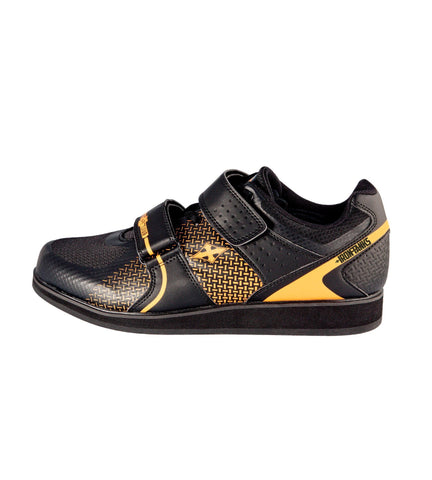Having the right training shoe can definitely make a difference to your comfort, strength and efficiency when you are undertaking squats and deadlifts at the gym.
A recent trend, though, has many lifters adopting a ‘monkey see, monkey do’ attitude towards footwear. And this isn’t ideal, if you’re looking to increase your own individual performance.
These days, there are plenty of options on the market. For instance, raised heels versus flat heels each serve very specific purposes and allow for specific benefits. But more and more lifters are simply copying others and wearing these types of shoes without understanding the difference between different variants.
There are key differences between these shoes and picking the right one is vital for you to get the most out of your training sessions.

The pros and cons of a raised heel
A raised heel is going to give you greater ankle mobility, which is a benefit for those who find their natural movement in this area inhibits them when lifting. This type of footwear also helps you stay upright, getting more lift out of your quads as a result. They’re also well-suited for those with strong legs.
If you have good strength in your hips, though, there is a chance that raised heels will make you overcorrect your squats when the weights reach maximum loads. This is a concern because it puts pressure on the lower back and can cause injuries over time.
Additionally, it can also lead you to pitch forward and lose balance during your techniques.
The pros and cons of a flat heel
If you adopt a wider stance when lifting and have a strong back and hips, a flat shoe is more likely to be suited to you. As you’ll be opting for a wider stance, you’re more likely to use your whole foot, not just the heel to push through in the lift.
If you lift with a more closed stance, however, you are going to push more with your heels; so the raised shoe is going to provide more benefits across the board.
It’s important to note that there are some exercises where the flat heel is going to be the inferior choice, though. For front squats, Olympic lifts and the overhead press – for example.
The simple answer is that there is no magic formula for which type of lifting shoe is right for you. Every lifter has differing levels of comfort and different techniques that will determine which type of footwear is right for them.
However, like choosing all types of workout gear, it is essential to make a decision based on your own abilities and behaviours. As these shoes are designed specifically for lifting, they are crafted to have strong, firm soles to provide a stable base for this kind of training. You wouldn’t opt for these if you’re looking to run marathons.
In comparison, normal running shoes or sneakers will offer zero support and will put you at risk of injury, when using them for heavy lifting and related techniques.

A great way to test which type of shoe is right for you is to first start by wearing flat footwear. Get into your squat stance and hold it for 10 seconds. Now, repeat this process but this time put a small weight under each of your heels. If you find that you can hold this squat position better this time around, then raised shoes are likely to be the more suitable option for you. Otherwise, if you are currently wearing a raised heel and find you can get into a comfortable squat stance with a flat outsole (and your heel doesn’t raise off the ground) then a flat soled shoe might be preferable for both your squat and deadlift.
When it comes to deadlifts, generally speaking, the flattest outsole that is incompressible will be the best shoe to lift in. The closer to the ground you are, the more stable you will be. It is important to have the least amount of cushioning – the firmer, flatter and closer to the ground the outsole is – the more force transmission from the floor to the barbell!




